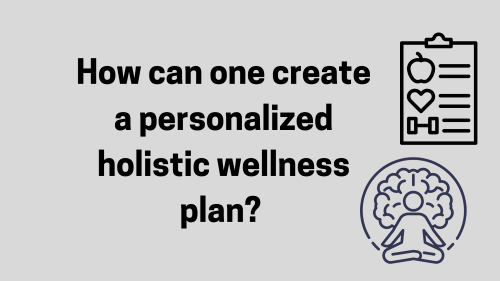
How can one create a personalized holistic wellness plan?
- Assess Your Current Health Status
- Define Your Wellness Goals
- Create a Balanced Nutrition Plan
- Develop a Regular Exercise Routine
- Practice Mindfulness and Stress Management
- Foster Emotional Health
- Cultivate Spiritual Practices
- Monitor and Adjust Your Plan
Introduction
To achieve balanced and all-encompassing well-being, a customized holistic wellness plan must be created. Your particular requirements and preferences should be considered, emphasizing physical, mental, emotional, and spiritual well-being. In this article, we’ll walk you through creating a holistic wellness plan to improve your overall quality of life.
1. Assess Your Current Health Status
First, determine how well you are now. Think about your entire state of health, which includes mental acuity, emotional stability, physical health, and spiritual fulfillment. Using the results of this evaluation, you may create reasonable goals and determine what needs to be improved.
2. Define Your Wellness Goals
Based on your health evaluation, establish attainable, well-defined wellness objectives. One of these objectives should cover every facet of holistic well-being. Building emotional resilience, decreasing stress, uplifting your physical activity level, and strengthening your spiritual practice are a few examples of goals you might have.
3. Create a Balanced Nutrition Plan
Nutrition greatly influences complete well-being. To preserve your mental and physical well-being, construct a meal plan that is balanced and rich in a range of whole foods, including whole grains, fruits, vegetables, lean meats, and veggies. Avoid processed foods and focus on making nutrient-dense food choices.
4. Develop a Regular Exercise Routine
Your wellness strategy should include frequent physical activity. Exercises like walking, running, yoga, or weight training are good options if they suit your fitness level and you enjoy them. Weekly moderate-intensity exercise should ideally total 150 minutes.
5. Practice Mindfulness and Stress Management
Reducing stress and cultivating mindfulness are essential for preserving mental and emotional health. Use tactics like awareness, deep breathing, and meditation throughout your everyday routine. These techniques facilitate emotional well-being, attention, and stress reduction.
6. Foster Emotional Health
A key component of emotional wellness is skillfully recognizing and controlling your feelings. Things like writing, going to therapy, and spending time with loved ones help maintain mental health. Emotional resilience also depends on forming solid, sustaining relationships.
7. Cultivate Spiritual Practices
Having a purpose and significance in life is essential to spiritual well-being. Practices that you find meaningful should be followed, such as prayer, meditation, or time spent in nature. Engaging in these activities may improve your general well-being, which fosters a sense of calm and community.
8. Monitor and Adjust Your Plan
If your holistic wellness plan needs to meet your requirements and goals, evaluate and tweak it frequently. Remain on track by monitoring your progress, acknowledging your successes, and making corrections. The effectiveness of a wellness strategy depends on its ability to adapt.
Conclusion
Developing a customized holistic wellness plan includes:
- Setting reasonable goals.
- Assessing your current health.
- Engaging in holistic wellness activities that enhance your mental, emotional, spiritual, and physical well-being.
By making the necessary adjustments to these phases, you can create a thorough strategy that improves your general quality of life. Take a balanced, individualized approach to your health and discover the life-changing advantages of embarking on a holistic wellness path now.
